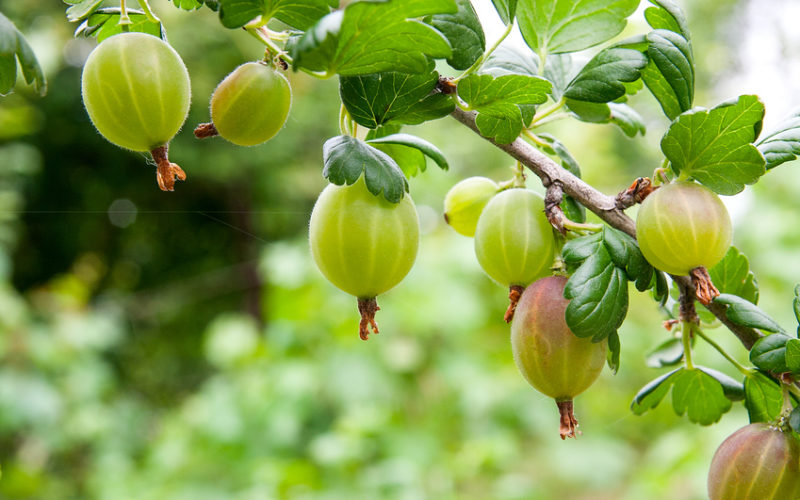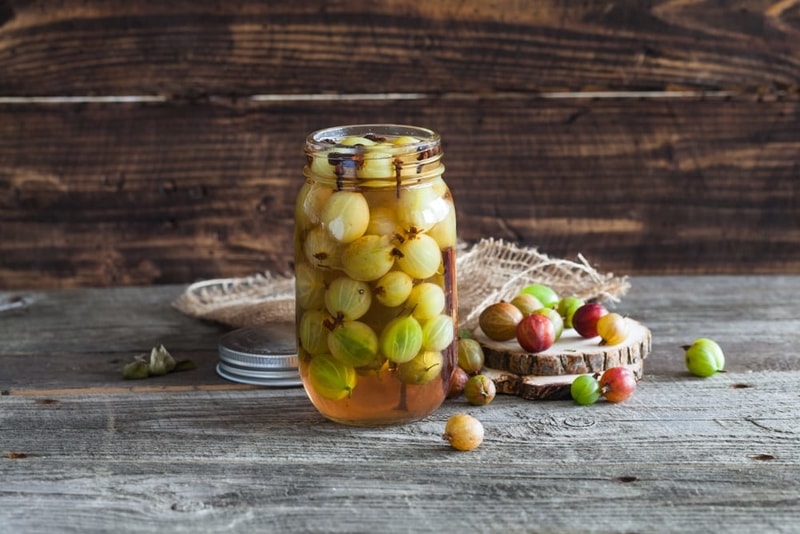You probably landed on this page with the intention of learning how to grow gooseberry plants and its berries, and in this article we’ll take you through how do exactly.
We’ll also take you through some of the benefits that the plant has, how to grow it more easily and some of the potential problems you could be running into in that process.
Some of the same issues that exist with black currant also exist with this type of berries.

What You Need to Know Before You Start Growing it
Before you start growing gooseberries in your garden, there’s a thing that you need to be aware of, and that’s the fact that it could actually be illegal to do so. Yes, that’s right, and it’s because of the same issue that exists with black currant, which is that they can grow a disease called white pine blister rust, which is a type of fungus that threatened the existence of pine trees in the US, which is a type of tree commonly used for wood siding.
Because of this fungus, black currant along with gooseberry was previously banned, although the regulations have been changed in a lot of countries since then. The ban was lifted because it was shown to only have a limited effect on keeping the spread from getting to pine trees. Vermont, Oregon, Connecticut and New York are some of the places where the ban was previously listed.
Since Massachusetts, Maine, New Hampshire and Rhode Island still ban black currant, these are among the states where you would need to ensure the planting of gooseberries in your garden is in fact legal.
Health Benefits
These berries have a range of different health benefits worth noting, yet another reason why some people choose to see if they can in fact get them readily available in their own backyard. The bushes they grow on are thorny, producing these small and firm berries.
The berries have properties helping against inflammation neurological diseases, cancer and more because of anthocyanins and flavones. They’re also a great source of antioxidants and vitamin C. While you might have thought that oranges were good for this purpose, this type of berry is significantly better.
How to Grow Gooseberry Plants
Gooseberry is a perennial plant, meaning one that lives more than two years, that gets up to 5 feet tall when it’s mature. They can grow in zones hardy through zone 3 with a strong preference for being planted in areas with full sun, and that’s where they’ll grow best. When you’re creating a vegetable garden, you may have heard that most plants and vegetables have a strong preference for well-drained but yet nutritious soil, and this plant is no exception. For this very reason, we also encourage you to read our article on making loam soil.
Planting and Spacing
Ideally, if you’re buying a plant, you will want 4-5 feet of space between them for bush plants, whereas cordons can be spaced 12-15 inches between them. Bamboo canes can be used for the cordons, and these should be secured to horizontal wire.
When you’re selecting the bush to grow 2-3 years with about 4 main, healthy branches is what you will want to choose. Compost will both help provide nutrients for the soil and keep the moisture in it, as mulch will too. Sappy growth can happen as a consequence of over-fertilization, and the mildew is more likely to appear on it, which is why you will want to limit the use of nitrogen-heavy fertilizers.
Pruning
With too many stems, the plant won’t have enough energy to properly grow either of the stems and to get better growth and more fruit, so you will want to prune and leave just 5 stems about 7 inches long to give them a good start. That is for bushes.
For cordons, prune it to the level just above a bud, and sideshoots near the ground should be removed too as well as ones not showing good potential.
That is the first year and is done in the early spring.
Older wood is where most of the fruit will be coming from, so you will want to leave that strong old wood unaffected, while shortening the bush back to five leaves. This is best done in the middle of the summer.
During the winter, you will want to remove shoots just above the ground as well as removing parts that are dead or without a lot of potential. Other sideshoots should be prunted to two or so buds away from the base to prepare them for the coming growth. This pruning should be repeated every year.
Pests and Diseases
There are different types of worms that are known to inhabit these. The gooseberry fruitworm and currantworm are among them. American gooseberry mildew and leafspot are some of the most common diseases. There are also common garden pests such as fruit flies, aphids, capsid bugs and other that may find your bush tempting territory to stay in.
Netting
Using netting when growing this plant serves a couple of different purposes. During the winter, the bullfinch bird will feed on the buds, but the net also provides protection of your valuable fruit when the ripening fruit is otherwise a good food source for a myriad of birds.
Treatment of the Mildew
The previously mentioned mildew will manifest itself as a powdery mildew, and the leaves can end up having a purple bronze appearance as a consequence. In fact, this type of mildew is not limited to these berries but can end up on other plants too. Especially at the earlier stages of the plant’s life, this will be problematic. When you start noticing this mildew, you will want to consider ways to improve the air circulation around the plants, as well as mulching the ground to keep the moisture in it.
Another factor that improves the conditions of this disease is when plants are planted too closely together, which also inhibits air circulation, and the use of high-nitrogen fertilizer should also be stopped when the problem is noticed. Always pay attention to the recommendations when it comes to planting the different plants, not just gooseberry, as this will also help lower the risk of having to deal with this mildew. In general, when you’re creating that beautiful garden, you will also want to look for plant varieties known to be more resistant towards diseases. When you see parts of the plant suffering, those should be pruned as soon as possible to remove the affected area and divert the plant’s energy towards growth in the healthy parts.
Several places online recommend specific disease-resistant varieties of gooseberries that include Keepsake, Hinnomaki Yellow and Red and Leveller. There are also studies suggesting that spraying your plants with a 10% milk to water solution helps keep a lot of diseases away, although when you go above 30%, it encourages the growth of fungus. Ideally skim milk is used for the purpose, so you would use 100ml skim milk to 900ml water.
What you need to be looking out for is grey-white fungal patches, and these turn darker over time. Signs will also be showing up on the berries. As well as not planting the plants too closely together, the pruning can also help in air circulation, and you should consider the general air circulation in the place where you’re considering planting them. This method of pruning also helps when it comes to picking the berries because of the thorny nature of the plant.
According to RHS the affected fruit is still edible after being cleaned and the fungus has been removed, and there are several different chemical solutions that can also be used such SB Plant Invigorator or Mildew Control.
When Should You Pick Them?
Since the berries don’t always change color, what are you basing it off when they should be picked? Their red color is an indication of them turning sweet, so when that happens you will want to consider picking them since they’ll at that point start becoming especially tempting to birds and bugs. If you’re not protecting them with a net, you’ll quickly find their numbers declining rapidly when you start letting them become more and more red, and very suddenly there will simply be none left and all that pruning and maintenance will have been in vain.
When you’re harvesting them, you will also want to be vary of potential bugs inside of them, and one good sign to be looking for is when one, or a few of them have a significantly different color than the others.

The purpose that you’ll be using them for should also influence when you decide to harvest them. Do you need them a bit more firm and bitter, like for preserves? Then go ahead and pick them a bit earlier. Color, size and firmness are the indicators you’re considering for the harvesting. Although they commonly turn red, white, yellow or pink are other options that can signal that they’re ready for harvest. Their texture is the clearest indication of their state, and you’ll therefore find yourself squeezing them to determine if they’re ready for eating or not. If they’re too firm, they’re probably not ready quite yet. The European variety is a bit bigger than the American, they’ll get to about an inch whereas the American is about half that, so knowing whether you’re growing one variety or the other is important.
Harvesting
With the nature of the fact that these bushes have thorns, harvesting them without getting cut or stung is more easily done with the use of high quality gloves. It’s possible to do it without them, but it makes your hands significantly more vulnerable, and injury is better avoided using proper protection. You know another thing that can be used in order to determine if the berries have the desired sweetness? Yes, you guessed right. You can actually just go ahead and taste them to see what you think. Remember how we told you to prune the branches that were too close to the ground? That’s because they’ll easily become overripe, and it’s better to focus all the plants energy going up.
Since some of the berries may have ripened slightly faster than is the case with others, you’ll want to continue monitoring them to make sure you harvest them when they’re at their best for your desired purpose, and that means looking at them on a weekly basis.
If you feel like they’re ripe now but you don’t wish to use them this very moment, they can be frozen. Alternatively, they can be refrigerated to keep them good for longer.
Fertilizing
Fertilizing is done in the early spring for gooseberries, and it should gently be worked into the soil too. You can take 1/4 to 1/2 pounds of it, or as otherwise specified by the manufacturer. If you use compost instead, you’ll want to affect the ratios of composted material to ensure it doesn’t get too heavy on nitrogen to help limit the potential of diseases.
Varieties
There are different varieties of gooseberries. The American ones originate from the northeastern part of the country and have great resistance towards a range of diseases, but as well already mentioned, they’re also smaller in size, and a lot of people prefer the taste of the European varieties too. With its bread properties that makes it able to withstand full sun, this variety is especially popular in the southern parts or in the Mediterranean. The European varieties is generally what’s bred for their taste and ability to grow in many different regions.
The European varieties can be a number of colors including purples, red, yellow or white with different textures too. The Honnonmakis Yellow is one variety that a lot of growers aprpeciate for the taste.
